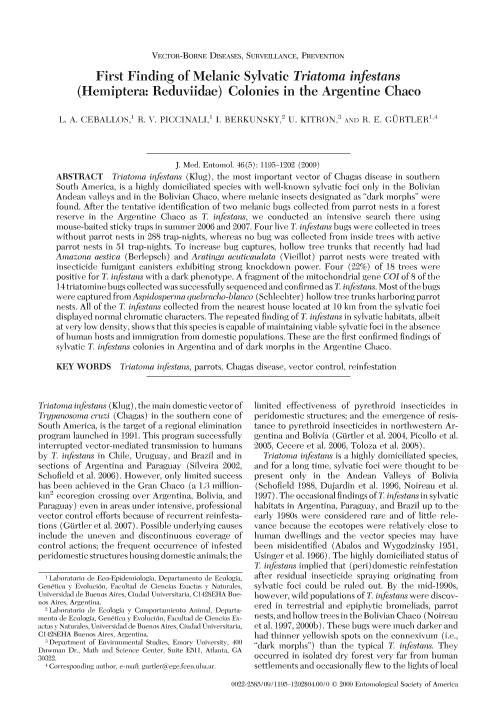Mostrar el registro sencillo del ítem
dc.contributor.author
Ceballos, L. A.
dc.contributor.author
Piccinali, Romina Valeria

dc.contributor.author
Berkunsky, Igor

dc.contributor.author
Kitron, U.
dc.contributor.author
Gurtler, Ricardo Esteban

dc.date.available
2023-02-01T10:56:23Z
dc.date.issued
2009-12
dc.identifier.citation
Ceballos, L. A.; Piccinali, Romina Valeria; Berkunsky, Igor; Kitron, U.; Gurtler, Ricardo Esteban; First finding of melanic sylvatic triatoma infestans (Hemiptera: Reduviidae) colonies in the Argentine Chaco; Entomological Society of America; Journal of Medical Entomology; 46; 5; 12-2009; 1195-1202
dc.identifier.issn
0022-2585
dc.identifier.uri
http://hdl.handle.net/11336/186379
dc.description.abstract
Triatoma infestans (Klug), the most important vector of Chagas disease in southern South America, is a highly domiciliated species with well-known sylvatic foci only in the Bolivian Andean valleys and in the Bolivian Chaco, where melanic insects designated as "dark morphs" were found. After the tentative identification of two melanic bugs collected from parrot nests in a forest reserve in the Argentine Chaco as T. infestans, we conducted an intensive search there using mouse-baited sticky traps in summer 2006 and 2007. Four live T. infestans bugs were collected in trees without parrot nests in 288 trap-nights, whereas no bug was collected from inside trees with active parrot nests in 51 trap-nights. To increase bug captures, hollow tree trunks that recently had had Amazona aestiva (Berlepsch) and Aratinga acuticaudata (Vieillot) parrot nests were treated with insecticide fumigant canisters exhibiting strong knockdown power. Four (22%) of 18 trees were positive for T. infestans with a dark phenotype. A fragment of the mitochondrial gene COI of 8 of the 14 triatomine bugs collected was successfully sequenced and confirmed as T. infestans. Most of the bugs were captured from Aspidosperma quebracho-blanco (Schlechter) hollow tree trunks harboring parrot nests. All of the T. infestans collected from the nearest house located at 10 km from the sylvatic foci displayed normal chromatic characters. The repeated finding of T. infestans in sylvatic habitats, albeit at very low density, shows that this species is capable of maintaining viable sylvatic foci in the absence of human hosts and immigration from domestic populations. These are the first confirmed findings of sylvatic T. infestans colonies in Argentina and of dark morphs in the Argentine Chaco.
dc.format
application/pdf
dc.language.iso
eng
dc.publisher
Entomological Society of America

dc.rights
info:eu-repo/semantics/openAccess
dc.rights.uri
https://creativecommons.org/licenses/by-nc-sa/2.5/ar/
dc.subject
CHAGAS DISEASE
dc.subject
PARROTS
dc.subject
REINFESTATION
dc.subject
TRIATOMA INFESTANS
dc.subject
VECTOR CONTROL
dc.subject.classification
Ecología

dc.subject.classification
Ciencias Biológicas

dc.subject.classification
CIENCIAS NATURALES Y EXACTAS

dc.title
First finding of melanic sylvatic triatoma infestans (Hemiptera: Reduviidae) colonies in the Argentine Chaco
dc.type
info:eu-repo/semantics/article
dc.type
info:ar-repo/semantics/artículo
dc.type
info:eu-repo/semantics/publishedVersion
dc.date.updated
2020-09-03T19:22:35Z
dc.journal.volume
46
dc.journal.number
5
dc.journal.pagination
1195-1202
dc.journal.pais
Estados Unidos

dc.journal.ciudad
Lanham
dc.description.fil
Fil: Ceballos, L. A.. Universidad de Buenos Aires. Facultad de Ciencias Exactas y Naturales. Departamento de Ecología, Genética y Evolución; Argentina
dc.description.fil
Fil: Piccinali, Romina Valeria. Consejo Nacional de Investigaciones Científicas y Técnicas. Oficina de Coordinación Administrativa Ciudad Universitaria. Instituto de Ecología, Genética y Evolución de Buenos Aires. Universidad de Buenos Aires. Facultad de Ciencias Exactas y Naturales. Instituto de Ecología, Genética y Evolución de Buenos Aires; Argentina
dc.description.fil
Fil: Berkunsky, Igor. Consejo Nacional de Investigaciones Científicas y Técnicas. Oficina de Coordinación Administrativa Ciudad Universitaria. Instituto de Ecología, Genética y Evolución de Buenos Aires. Universidad de Buenos Aires. Facultad de Ciencias Exactas y Naturales. Instituto de Ecología, Genética y Evolución de Buenos Aires; Argentina
dc.description.fil
Fil: Kitron, U.. University of Emory; Estados Unidos
dc.description.fil
Fil: Gurtler, Ricardo Esteban. Consejo Nacional de Investigaciones Científicas y Técnicas. Oficina de Coordinación Administrativa Ciudad Universitaria. Instituto de Ecología, Genética y Evolución de Buenos Aires. Universidad de Buenos Aires. Facultad de Ciencias Exactas y Naturales. Instituto de Ecología, Genética y Evolución de Buenos Aires; Argentina
dc.journal.title
Journal of Medical Entomology

dc.relation.alternativeid
info:eu-repo/semantics/altIdentifier/url/https://academic.oup.com/jme/article/46/5/1195/905283?login=false
dc.relation.alternativeid
info:eu-repo/semantics/altIdentifier/doi/http://dx.doi.org/10.1603/033.046.0530
Archivos asociados
